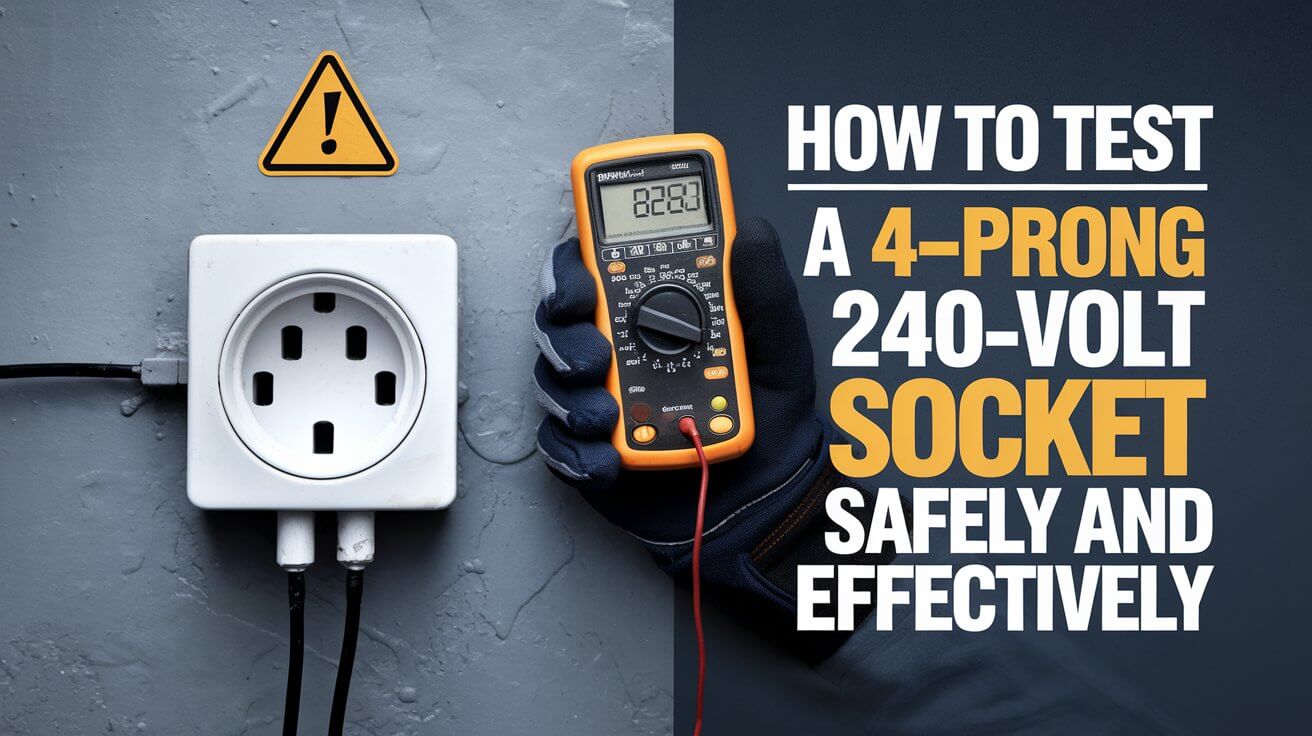How to Test a 4-Prong 240-Volt Socket Safely and Effectively

Testing a 4-prong 240-volt socket is essential to ensure the safety and functionality of appliances that require higher voltages, such as dryers, stoves, or heavy-duty power tools. With the right tools and precautions, homeowners can safely confirm if their 240-volt outlets are working correctly. This guide walks you through the detailed steps to test a 4-prong 240-volt socket, covering everything from tools and safety measures to troubleshooting and practical tips.
Tools You Will Need to Test a 4-Prong 240-Volt Socket
Before beginning the testing process, ensure you have the following tools:
Multimeter
A multimeter is the primary tool you’ll need to measure voltage levels in your socket. When testing a 240-volt socket, set the multimeter to read AC voltage at a range that includes 240V (typically 250V). A multimeter can also help check for continuity and verify the correct wiring of the socket.
Safety Gear
Wearing the right safety equipment is critical. Electrical work can be dangerous, especially when dealing with high-voltage outlets like 240V sockets. Equip yourself with:
- Insulated gloves: These will protect you from electrical shocks.
- Safety glasses: To protect your eyes from potential sparks or flying debris.
Voltage Tester (Optional)
A voltage tester can be an additional, simpler tool to confirm whether power is flowing to the socket. Though not as accurate as a multimeter, it’s quick and effective for basic checks.
Safety Precautions Before Testing a 240-Volt Socket
Testing a high-voltage socket comes with risks, and it’s essential to take the necessary precautions to avoid accidents or damage.
Turn Off Power at the Breaker Box
Before you begin testing, always turn off the power to the socket by switching off the corresponding circuit breaker in your breaker box. High-voltage electricity is extremely dangerous, and cutting off the power minimizes the risk of electrocution.
Inspect the Wiring
Once the power is off, visually inspect the socket for any signs of damage or wear. Loose, burnt, or frayed wires can indicate bigger electrical issues. If you notice any of these, avoid proceeding until a professional electrician can inspect and fix the problem.
Proper Grounding
Ensure the outlet is properly grounded. This is especially crucial for 240-volt sockets, as faulty grounding can lead to electric shocks or even fires. In a 4-prong socket, the fourth prong is the ground, while the other three prongs serve as two hot wires and one neutral wire.
Step-by-Step Guide to Testing a 4-Prong 240-Volt Socket
Let’s walk through how to test your 4-prong 240-volt socket step by step.
Step 1: Locate and Identify the Socket
The first thing you need to do is locate the 4-prong 240-volt socket in your home. These outlets are typically used for heavy appliances like dryers or electric ranges. You can identify them by their four slots: two hot wires, one neutral wire, and one ground.
Why four prongs? In 1996, electrical standards changed to require a fourth wire (neutral) for better safety. Appliances that run on 240V, but have electronic controls or motors running on 120V, need this neutral wire. If your outlet was installed before 1996, it may have three prongs instead of four, but for modern setups, a 4-prong outlet is safer and more efficient.
Step 2: Set Up the Multimeter
Next, grab your multimeter and set it to the AC voltage mode. Ensure that the range includes 240V, usually the 250V or 300V setting, depending on your model. Insert the probes into the proper ports of the multimeter: the red probe into the voltage (V) port, and the black probe into the common (COM) port.
Step 3: Testing the Hot, Neutral, and Ground Connections
Now you can begin testing.
- Test between the two hot slots: Insert the red and black probes into the two hot slots of the socket (the two angled or straight blades). The multimeter should read 240V between these two points.
- Check for 120V on each hot wire: Next, test each hot wire against the neutral and ground prongs individually. Insert one probe into the hot slot and the other into the neutral (or ground) slot. You should get a reading of approximately 120V each time. If both readings are around 120V, the socket is working correctly.
No Voltage? Troubleshooting Steps
If your multimeter shows no voltage or an incorrect reading, there could be several issues:
- Circuit Breaker Tripped: Check if the breaker has tripped and reset it if necessary.
- Faulty Wiring: Loose or damaged wires can prevent proper voltage flow.
- Damaged Socket: In some cases, the socket itself might be faulty and may need replacement.
If you’re unsure about any issues, contact a licensed electrician.
Troubleshooting Common Issues with 240-Volt Sockets
Even after testing, you might still encounter issues with your 240-volt outlet. Here are some common problems and how to address them.
Circuit Breaker Issues
If the circuit breaker keeps tripping when the outlet is in use, it may indicate an overloaded circuit or faulty wiring. Start by checking the load on the circuit; if too many appliances are connected, try redistributing them to prevent overloading.
Loose or Damaged Wires
Over time, wires can become loose or damaged, leading to intermittent or no power at all. If you suspect loose wiring, turn off the power and remove the outlet’s faceplate to inspect the wires. Tighten any loose connections, and if the wiring looks damaged, consider replacing it.
Replacing a Faulty Outlet
If after troubleshooting, the outlet still doesn’t work, it may be time to replace it. Replacing a 240-volt outlet requires careful attention to wiring, especially in aligning the hot, neutral, and ground connections correctly. For safety reasons, hiring a professional electrician is advisable if you’re unsure of the process.
How to Test if the Outlet is Wired Correctly
Testing the wiring of your 4-prong 240-volt outlet ensures that each prong functions as intended. Incorrect wiring can be dangerous, leading to shocks, electrical damage, or appliance malfunctions.
Check Prong Layout
A standard 4-prong outlet has two hot wires, one neutral wire, and one ground wire:
- Two hot prongs (typically angled or straight) supply the 240 volts.
- Neutral prong provides a return path for any 120V components.
- Ground prong is for safety, grounding the electrical system to avoid shocks.
Verifying Correct Wiring
Use your multimeter to check the voltage between each prong:
- Hot to hot should read 240 volts.
- Hot to neutral should read 120 volts.
- Hot to ground should also read 120 volts.
If these values aren’t correct, there may be an issue with the socket wiring, and it should be inspected and repaired by a professional.
Potential Risks of Incorrect Wiring
Improperly wired 240-volt outlets pose serious risks, such as:
- Electric shock: If the neutral and ground wires are crossed or miswired, appliances might receive incorrect voltages, leading to potential shock hazards.
- Fire risk: Faulty connections can overheat, causing fires.
- Appliance damage: Appliances requiring specific voltages may get damaged if incorrect voltages are supplied.
Ensuring the Longevity and Safety of 240-Volt Sockets
240-volt sockets are built to handle heavy electrical loads, but like any electrical component, they require regular maintenance and checks to stay safe and functional.
Routine Maintenance
Inspect your high-voltage outlets regularly for any signs of wear or damage. Dust and debris can collect inside the prongs, leading to poor connections or overheating. If you use the outlet often for appliances like dryers or ovens, check the plug and outlet for burn marks or discolored prongs.
Upgrading to Safer Standards
If you live in an older home with 3-prong 240-volt outlets, consider upgrading to 4-prong versions. Not only are 4-prong outlets safer due to the separate neutral and ground connections, but they also meet modern safety codes.
Frequently Asked Questions (FAQ) on Testing 240-Volt Sockets
Can I Test a 240-Volt Socket without a Multimeter?
Yes, you can use a voltage tester, which is simpler but less accurate than a multimeter. However, a multimeter provides more detailed information, including specific voltage readings that can help diagnose issues more effectively.
What Should I Do If I Don’t Get a 240-Volt Reading?
If the reading is incorrect, check the circuit breaker to ensure it’s turned on and not tripped. Also, verify that the multimeter is set correctly and the probes are properly connected. If these steps don’t resolve the issue, you may have a wiring or outlet problem that requires professional attention.
How Can I Identify a 240-Volt Outlet?
240-volt outlets are larger than standard outlets and have four slots: two angled (or straight) hot prongs, one neutral prong, and one ground prong. They are typically used for large appliances like dryers and stoves.
Conclusion: Safely Testing Your 4-Prong 240-Volt Socket
Testing a 4-prong 240-Testing a 4-prong 240-volt socket is crucial for ensuring the safety of your household appliances and the integrity of your electrical system. Following the proper steps, using the right tools, and adhering to safety precautions can help you verify that your socket is wired correctly and functioning as intended. Below is a detailed guide to safely and efficiently test your 4-prong 240-volt outlet.




